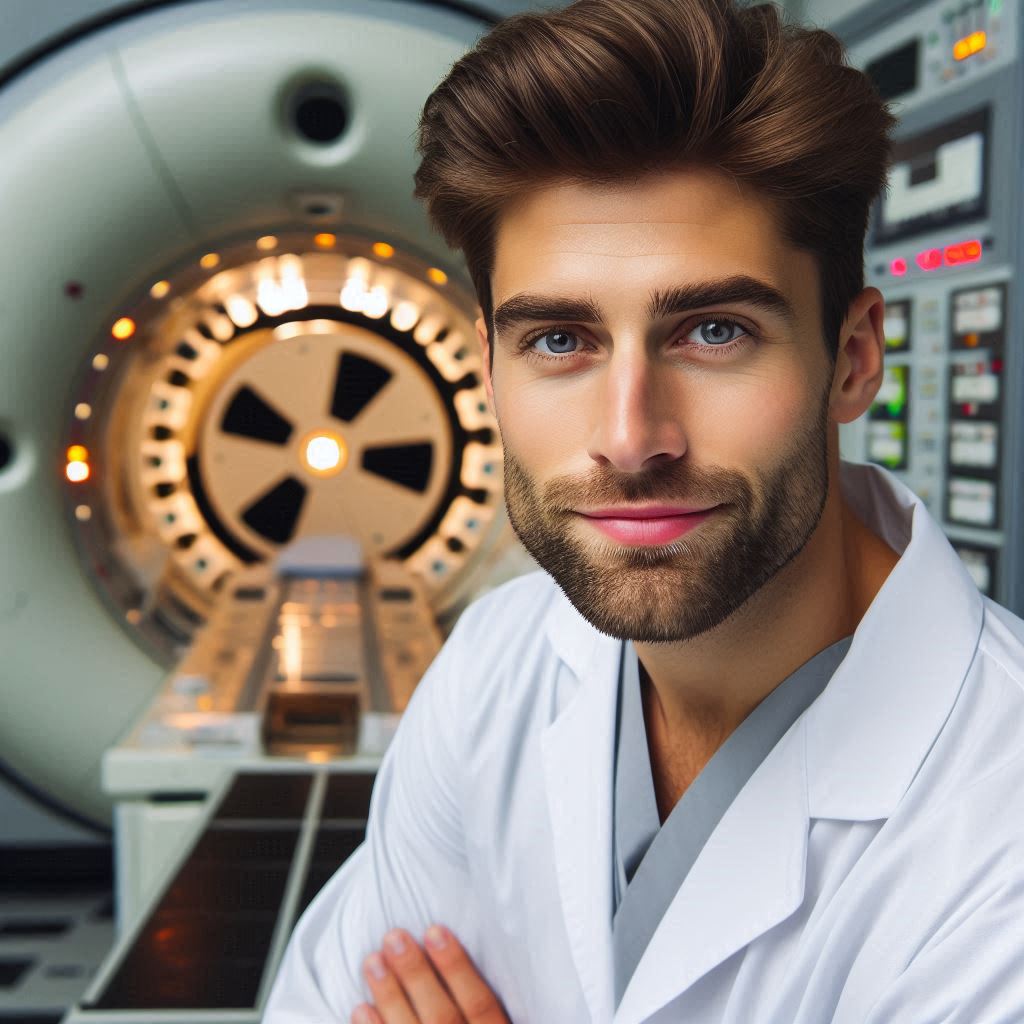Introduction
Nuclear medicine technologists play a crucial role in the field of diagnostics by using radioactive materials to diagnose and treat a variety of medical conditions.
Nuclear medicine technologists are healthcare professionals who prepare and administer radioactive drugs for imaging procedures to help diagnose and treat diseases.
They operate sophisticated imaging equipment to capture images of the body’s organs and tissues, allowing physicians to detect abnormalities or diseases.
Nuclear medicine is essential in diagnosing various conditions such as cancer, heart disease, and neurological disorders.
It provides detailed information about a patient’s internal organs, functioning, and overall health, aiding in accurate diagnosis and treatment planning.
Nuclear medicine technologists ensure that imaging procedures are conducted safely and effectively, playing a vital role in delivering high-quality patient care.
Role of nuclear medicine technologists in patient care
Administration of radioactive drugs for imaging
Nuclear medicine technologists play a vital role in patient care by administering radioactive drugs for imaging.
They prepare the radiopharmaceuticals carefully to ensure proper dosages. These professionals explain the procedure to patients, addressing any concerns.
They inject or provide the drugs orally, depending on the imaging requirements. Monitoring the patient’s response to the drugs is crucial to their role.
They maintain detailed records of the administered radiopharmaceuticals. Their expertise ensures the accurate delivery of these drugs for optimal imaging results.
Conducting scans and capturing images
After administering the drugs, nuclear medicine technologists conduct scans and capture images.
They operate sophisticated imaging equipment, such as gamma cameras and PET scanners. Positioning patients correctly is essential for high-quality images.
They ensure that patients remain still during the scanning process. These technologists adjust equipment settings to obtain the best possible images.
They interpret initial results and relay important information to physicians.
Their skills in image acquisition are crucial for accurate diagnostics and treatment planning.
Ensuring patient safety during procedures
Ensuring patient safety is a top priority for nuclear medicine technologists during procedures. They follow strict safety protocols to minimize radiation exposure.
Technologists wear protective gear and use shielding devices. They educate patients on safety measures and answer any questions.
Monitoring patients for adverse reactions during and after the procedure is essential.
They maintain a clean and safe environment, adhering to regulatory standards.
Their vigilance and adherence to safety protocols protect patients and themselves from unnecessary risks.
Transform Your Career Today
Unlock a personalized career strategy that drives real results. Get tailored advice and a roadmap designed just for you.
Start NowIn summary, nuclear medicine technologists are integral to patient care through the administration of radioactive drugs, conducting scans, and ensuring safety.
Their expertise ensures accurate diagnostics and patient well-being throughout the imaging process.
Read: Nuclear Medicine Tech: Important Safety Measures
Training and education required to become a nuclear medicine technologist
When it comes to the role of nuclear medicine technologists in diagnostics, it is crucial to understand the training and education required to pursue this career path.
Becoming a nuclear medicine technologist involves a combination of academic qualifications, licensing and certification requirements, as well as continuing education for career advancement.
Academic Qualifications
To begin a career as a nuclear medicine technologist, individuals must first obtain a minimum of an associate’s degree in nuclear medicine technology.
This program typically includes coursework in anatomy, physiology, physics, radiation safety, and patient care.
In addition to classroom lectures, students also participate in clinical training to gain hands-on experience in a healthcare setting.
Licensing and Certification Requirements
After completing their education, aspiring nuclear medicine technologists must obtain a state license to practice in their respective state.
Licensing requirements may vary from state to state but generally involve passing a certification exam administered by the Nuclear Medicine Technology Certification Board (NMTCB) or the American Registry of Radiologic Technologists (ARRT).
Certification demonstrates that technologists have met the national standards for competency and skill in the field.
Continuing Education for Career Advancement
Once licensed and certified, nuclear medicine technologists can further their education and enhance their skills through continuing education programs.
These programs help technologists stay up-to-date with the latest advancements in technology, procedures, and patient care practices.
Continuing education courses may cover topics such as new imaging techniques, radiation safety protocols, and pharmacology updates.
By participating in continuing education, technologists can expand their knowledge base and improve their overall performance in the field.
In fact, the training and education required to become a nuclear medicine technologist are rigorous and demanding.
However, with the right qualifications, certifications, and ongoing education, technologists can provide valuable contributions to the field of diagnostics and play a crucial role in patient care.
Read: Career Advancement Opportunities for Sonographers
Advanced technologies used in nuclear medicine diagnostics
When it comes to the field of nuclear medicine diagnostics, nuclear medicine technologists play a crucial role in operating advanced technologies to help diagnose and treat various medical conditions.
Showcase Your Business Today
Reach thousands of readers actively exploring professional services. Publish your business profile and grow your audience now.
Publish NowLet’s delve into some of the advanced technologies used in nuclear medicine diagnostics:
PET Scans
Positron Emission Tomography (PET) scans are a powerful imaging technique that involves the use of radioactive tracers to visualize and measure metabolic processes in the body.
These scans are instrumental in detecting abnormalities at the cellular level, making them invaluable in the diagnosis and monitoring of various diseases such as cancer, neurological disorders, and cardiovascular conditions.
SPECT Scans
Single Photon Emission Computed Tomography (SPECT) scans are another essential tool in nuclear medicine diagnostics.
SPECT imaging uses radioactive tracers to create 3D images of the organs and tissues inside the body.
This technology is particularly useful in providing detailed information about organ function, blood flow, and tissue viability, helping physicians make accurate diagnoses and treatment plans for patients.
Hybrid Imaging Modalities like PET/CT and SPECT/CT
Combining the strengths of both nuclear medicine and traditional imaging modalities, hybrid imaging techniques like PET/CT and SPECT/CT offer comprehensive information about both structure and function in a single diagnostic procedure.
PET/CT combines PET’s metabolic information with CT’s anatomical detail, providing a more precise localization of abnormalities.
Similarly, SPECT/CT combines SPECT’s functional data with CT’s anatomical images, allowing for improved diagnostic accuracy and treatment planning for various conditions.
Overall, nuclear medicine technologists play a pivotal role in the successful implementation of these advanced technologies in diagnostics.
Their expertise in operating and maintaining imaging equipment, preparing and administering radiopharmaceuticals, and ensuring patient safety and comfort during procedures is essential for obtaining accurate and reliable diagnostic information.
With their specialized training and skills, nuclear medicine technologists contribute significantly to the field of nuclear medicine and play a critical role in improving patient care and outcomes.
Read: Common Challenges Faced by Ultrasound Technicians

Collaboration with other healthcare professionals
When it comes to the role of nuclear medicine technologists in diagnostics, collaboration with other healthcare professionals is key.
Let’s take a closer look at how they work with different medical experts:
Working with Radiologists and Referring Physicians
Nuclear medicine technologists often work closely with radiologists and referring physicians to ensure proper imaging procedures are carried out.
They rely on the expertise of radiologists to interpret images and provide accurate diagnoses.
Referring physicians depend on the results of these imaging tests to make informed decisions about a patient’s treatment plan.
Interpreting Imaging Results
Nuclear medicine technologists play a crucial role in interpreting imaging results.
They are trained to identify abnormalities or irregularities in images that may indicate potential health issues.
This information is vital for radiologists and physicians to make accurate diagnoses and develop appropriate treatment plans for patients.
Their expertise in this area helps streamline the diagnostic process and ensure that patients receive the care they need in a timely manner.
Participating in Treatment Planning Discussions
Another important aspect of the role of nuclear medicine technologists in diagnostics is participating in treatment planning discussions.
They collaborate with radiologists, referring physicians, and other healthcare professionals to provide input on the best course of action for patients based on imaging results.
Their insights help shape treatment plans and ensure that patients receive comprehensive care that addresses their specific health needs.
In general, nuclear medicine technologists play a vital role in diagnostics by collaborating with other healthcare professionals, working with radiologists and referring physicians, interpreting imaging results, and participating in treatment planning discussions.
Their contributions help ensure accurate diagnoses, effective treatment plans, and optimal patient care.
Read: Exploring the Work Environment of a Sonographer
Gain More Insights: Impact of Public Health Administrators on Communities
Challenges Faced by Nuclear Medicine Technologists
Exposure to Radiation
Nuclear medicine technologists are constantly exposed to radiation during imaging procedures.
This exposure must be carefully monitored to minimize potential health risks.
Technologists must follow strict safety protocols to protect themselves and patients from radiation exposure.
Regular training and education on radiation safety are essential for nuclear medicine technologists.
Ensuring Accurate Imaging Results
One of the main challenges for nuclear medicine technologists is to ensure the accuracy of imaging results.
They must position patients correctly and operate imaging equipment with precision.
Any errors in positioning or equipment operation can result in inaccurate imaging results.
Quality control checks are crucial to verify the accuracy of imaging studies.
Adapting to New Technologies and Techniques
With rapid advancements in technology, nuclear medicine technologists must constantly adapt to new technologies.
This requires ongoing training and professional development to stay updated on the latest techniques.
Technologists need to be proficient in using new imaging equipment and software programs.
Showcase Your Business Today
Reach thousands of readers actively exploring professional services. Publish your business profile and grow your audience now.
Publish NowKeeping pace with technological advancements is essential to delivering high-quality diagnostic services.
In a nutshell, nuclear medicine technologists face various challenges in their profession.
From managing radiation exposure to ensuring accurate imaging results and adapting to new technologies, they play a crucial role in diagnostic medicine.
Continuous training and emphasis on safety protocols are essential to overcome these challenges and provide quality patient care.
Learn More: Continuing Education for Sleep Technologists
Conclusion
As we wrap up, nuclear medicine technologists play a crucial role in diagnostic procedures.
Their expertise in handling radioactive materials and operating imaging equipment is essential.
Their contribution to diagnostic medicine cannot be overstated.
They assist in identifying diseases, monitoring treatment effectiveness, and providing valuable data to healthcare professionals.
Looking ahead, the field of nuclear medicine technology is poised for growth.
With advancements in imaging technology and increased demand for accurate diagnostic procedures, the need for skilled technologists will continue to rise.
[E-Books for Sale]
The Big Book of 500 High-Paying Jobs in America: Unlock Your Earning Potential
$19.99 • 500 High-Paying Jobs • 330 pages
Explore 500 high-paying jobs in America and learn how to boost your career, earn more, and achieve success!
See All 500 High-Paying Jobs of this E-Book
1001 Professions Without a Degree: High-Paying American Jobs You Can Start Now
$19.99 • 1001 Professions Without a Degree • 174 pages
Discover 1001 high-paying jobs without a degree! Unlock career tips, skills, and success strategies for just $19.99!




